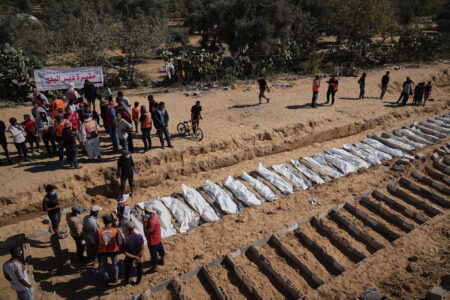Haiti, Jamaica, Cuba pick up pieces
SANTIAGO DE CUBA, Cuba — The rumble of large machinery, whine of chain saws and chopping of machetes echoed through communities across the northern Caribbean on Thursday as they dug out from the destruction of Hurricane Melissa and surveyed the damage left behind.
In Jamaica, government workers and residents began clearing roads in a push to reach dozens of isolated communities in the island’s southeast that sustained a direct hit from one of the most powerful Atlantic hurricanes on record.
Stunned residents wandered about, some staring at their roofless homes and waterlogged belongings strewn around them.
“I don’t have a house now,” said Sylvester Guthrie, a resident of Lacovia in the southern parish of St. Elizabeth, as he held onto his bicycle, the only possession of value left after the storm.
Emergency relief flights were landing at Jamaica’s main international airport as crews distributed water, medicine and other basic supplies. Helicopters dropped food as they thrummed above communities where the storm flattened homes, wiped out roads and destroyed bridges, cutting them off from assistance.
“The entire Jamaica is really broken because of what has happened,” Education Minister Dana Morris Dixon said.
Officials said at least 19 people have died in Jamaica, including a child, and they expected the death toll to keep rising. In one isolated community, residents pleaded with officials to remove the body of one victim tangled in a tree. On Thursday, dozens of U.S. search-and-rescue experts landed in Jamaica along with their dogs.
More than 13,000 people remained crowded into shelters, with 72% of the island without power and only 35% of mobile phone sites in operation, officials said. People clutched cash as they formed long lines at the few gas stations and supermarkets open in affected areas.
“We understand the frustration, we understand your anxiety, but we ask for your patience,” said Daryl Vaz, Jamaica’s telecommunications and energy minister.
Water trucks have been mobilized to serve many of Jamaica’s rural communities that are not connected to the government’s utility system, Water Minister Matthew Samuda said.
In Cuba, heavy equipment began to clear blocked roads and highways and the military helped rescue people trapped in isolated communities and at risk from landslides.
No deaths were reported after the Civil Defense evacuated more than 735,000 people across eastern Cuba ahead of the storm. Residents were slowly starting to return home Thursday.
The town of El Cobre in the eastern province of Santiago de Cuba was one of the hardest hit. Home to some 7,000 people, it is also the site of the Basilica of Our Lady of Charity, the patron saint of Cuba who is deeply venerated by Catholics and practitioners of Santería, an Afro-Cuban religion.
“We went through this very badly. So much wind, so much wind. Zinc roofs were torn off. Some houses completely collapsed. It was a disaster,” said Odalys Ojeda, a 61-year-old retiree, as she looked up at the sky from her living room where the roof and other parts of the house were torn away.
Even the basilica wasn’t spared.
“Here at the sanctuary, the carpentry, stained glass and even the masonry suffered extensive damage,” Father Rogelio Dean Puerta said.
A televised Civil Defense meeting chaired by President Miguel Díaz-Canel did not provide an official estimate of the damage. However, officials from the affected provinces — Santiago, Granma, Holguín, Guantánamo, and Las Tunas — reported losses of roofs, power lines and fiber optic telecommunications cables, as well as roads cut off, isolating communities, and heavy losses in banana, cassava and coffee plantations.
Many communities were still without electricity, internet and telephone service because of downed transformers and power lines.

